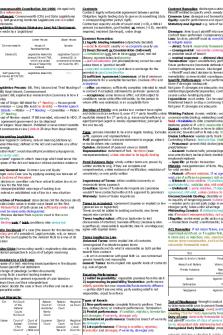Lecture notes, lecture 5 - Indepth notes for final, with table for practical component PDF

| Title | Lecture notes, lecture 5 - Indepth notes for final, with table for practical component |
|---|---|
| Course | Sport Therapy |
| Institution | University of Windsor |
| Pages | 2 |
| File Size | 77 KB |
| File Type | |
| Total Downloads | 22 |
| Total Views | 136 |
Summary
indepth notes for final, with table for practical component...
Description
Injury to the Head and Face BRAIN INJURY CLASSIFICATION -
-
Cerebral concussions – very common Mild head injury (MHI) –fairly uncommon Unable to repair itself Damage often permanent 20% of athletes suffer a concussion/year 145 000 reported cases/year
DEFINITION OF CONCUSSION -
-
Linear – most common Depressed – very forceful blow
GLASCOW COMA SCALE -
The lower the score, the more severe the concussion More objective Injury
Rapid onset, short lived symptoms
GRADUATED RTP PROTOCOL
2 TYPES OF FRACTURES -
Best eye response Best verbal response Best motor response
-
No activity recovery Light aerobic exercise increase HR Sport specific exercise add movement Non-contact training drills exercise, coordination, and cognitive load progressive resistance training Full contact practice restore confidence and assess functional skills by coaching staff Return to play
Etiology
S&S
Skull injury
Blunt trauma
Headache Nausea Palpable defect
Concussion
Direct blow to the head or elsewhere creating enough force to be transmitted through the head
Facial Fractures
Direct blow
Somatic, cognitive, and emotional symptoms Physical signs Behavioral changes Cognitive impairment Sleep disturbance Depression Pain Swelling Discoloration Deformity Swelling Malocclusion – in ability to close jaw TMJ dislocation – lock jaw
Mandibular Fracture
Management Fractured basilar or ethmoid bones – leakage of CSF Battle sign – ecchymosis at mastoid process Raccoon eyes Graduated RTP Protocol 4 hours per set ( 1 full week) If recurrence of symptoms at any step, individual returns to precious asymptomatic step for 24hrs
Deformity Swelling Bleeding Deformity Intruded Extruded
Zygomatic Fracture Dental Injuries
Auricular Hematoma aka Cauliflower Ear
Eye Injuries
Orbital Fractures
Nasal Injuries
Skin Injuries
Onset – acute or chronic pain trauma or constant pressure Direct blow Abrasion and penetration Hyphema – bleeding in anterior portion of the eye Blow out – medial or floor, lacrimal, ethmoid, maxilla Blow up – less common, orbital roof Ball, elbow, blunt object Direct blow
Abrasion Laceration Incision
Redness Swelling Deformity
Deformity Sunken eye Medially displaced Inability to look up Pain Epistaxis Swelling Raccoon eyes
Do not handle Wear glove Wash with saline Reimplant if possible Store in cold milk Transport to dentist within 30 minutes Ice Referral
Most common nasal facial fracture Direct pressure to stop bleeding Ice Return to play with gauze if bleeding did not stop First aid Refer for stitches...
Similar Free PDFs

5. Demand for HC - Lecture notes 5
- 17 Pages

Lecture Notes for DMC
- 16 Pages

Lecture notes for law
- 2 Pages

Integumentary notes for lecture
- 8 Pages

Lecture Notes for sy216
- 23 Pages

Vsepr Table - lecture notes
- 1 Pages

Lecture Notes for the class
- 108 Pages

Lecture notes for this class
- 3 Pages

Taxation lecture notes for Finals
- 26 Pages
Popular Institutions
- Tinajero National High School - Annex
- Politeknik Caltex Riau
- Yokohama City University
- SGT University
- University of Al-Qadisiyah
- Divine Word College of Vigan
- Techniek College Rotterdam
- Universidade de Santiago
- Universiti Teknologi MARA Cawangan Johor Kampus Pasir Gudang
- Poltekkes Kemenkes Yogyakarta
- Baguio City National High School
- Colegio san marcos
- preparatoria uno
- Centro de Bachillerato Tecnológico Industrial y de Servicios No. 107
- Dalian Maritime University
- Quang Trung Secondary School
- Colegio Tecnológico en Informática
- Corporación Regional de Educación Superior
- Grupo CEDVA
- Dar Al Uloom University
- Centro de Estudios Preuniversitarios de la Universidad Nacional de Ingeniería
- 上智大学
- Aakash International School, Nuna Majara
- San Felipe Neri Catholic School
- Kang Chiao International School - New Taipei City
- Misamis Occidental National High School
- Institución Educativa Escuela Normal Juan Ladrilleros
- Kolehiyo ng Pantukan
- Batanes State College
- Instituto Continental
- Sekolah Menengah Kejuruan Kesehatan Kaltara (Tarakan)
- Colegio de La Inmaculada Concepcion - Cebu






